Key takeaways:
- Selective Mutism is a complex anxiety disorder, not just shyness, impacting children’s communication abilities.
- Mindfulness techniques, such as deep breathing and body scanning, help manage anxiety and enhance self-awareness.
- Daily mindfulness practices, like gratitude reflection and mindful walking, cultivate a positive outlook and presence in daily life.
- Mindfulness fosters emotional intelligence, enabling deeper connections and communication, even in silence.

Understanding Selective Mutism
Selective Mutism is often misunderstood as mere shyness, but in my experience, it’s a complex anxiety disorder that can deeply impact a child’s ability to communicate. I remember feeling like I was trapped inside my own mind, wanting to speak but finding the words lodged in my throat, almost as if a thick fog clouded my voice. It’s a heart-wrenching experience that can leave both the child and their loved ones feeling frustrated and helpless.
Many children with selective mutism show a stark contrast between their spoken abilities at home and their silence in social settings. This disparity can confuse families and educators. I often wondered, is it fear of judgment? Or perhaps a feeling of being out of place? In my case, the silence was a protective shield that felt safer than the vulnerability of speaking in unfamiliar environments.
Understanding selective mutism means recognizing that it isn’t a choice; it’s a response to overwhelming anxiety. There were moments when I felt completely alone in my struggle, yet I’ve learned that shared experiences can be a powerful source of comfort. Connecting with others who understand this journey has been invaluable in realizing that seeking help is not just okay, but essential.
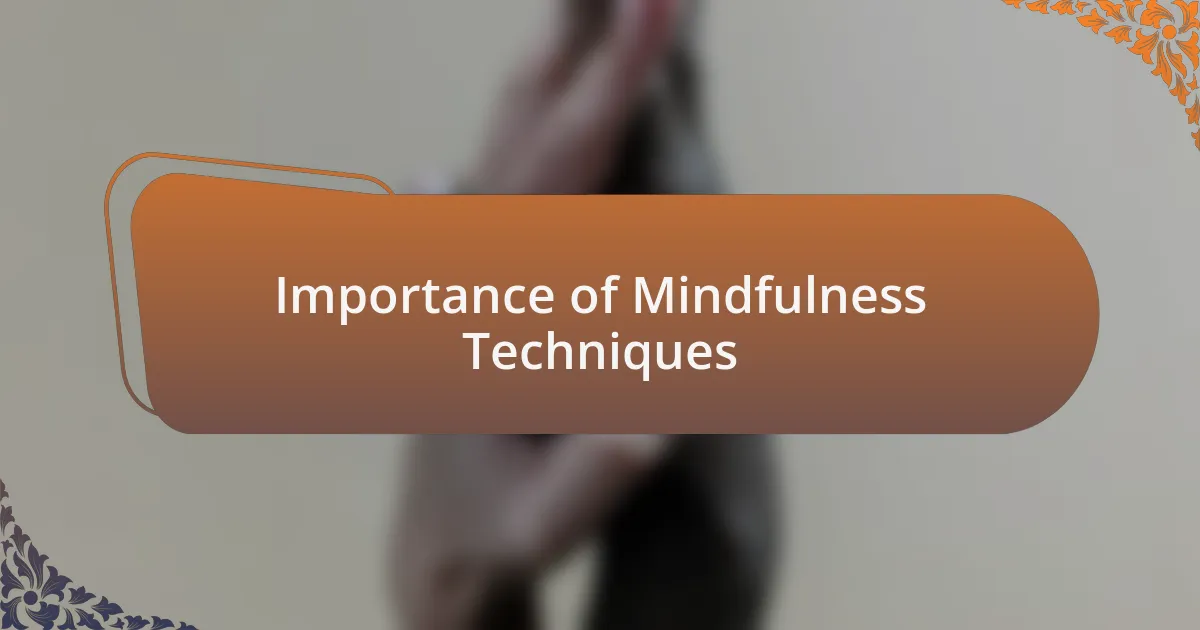
Importance of Mindfulness Techniques
Mindfulness techniques hold immense importance, especially for those of us navigating the complexities of selective mutism. When I first tried focusing on my breath or noticing the sensations around me, I felt an unexpected sense of relief. This practice allowed me to acknowledge my anxiety without judgment, creating a space where I could simply exist.
One day, during a particularly overwhelming moment at school, I practiced mindfulness by concentrating on the rhythm of my breathing. That simple shift—focusing inward rather than on the daunting external world—helped ground me. I discovered that these small moments of awareness had the power to reduce my anxiety, allowing me to slowly engage more with my surroundings.
Integrating mindfulness into daily routines can be transformative. Have you ever noticed how just five minutes of being present can shift your entire mood? For me, these moments cultivated resilience, making it easier to express myself over time. I’ve realized that mindfulness isn’t just a technique; it’s a gentle reminder that I can take control of my feelings, even in the face of silence.
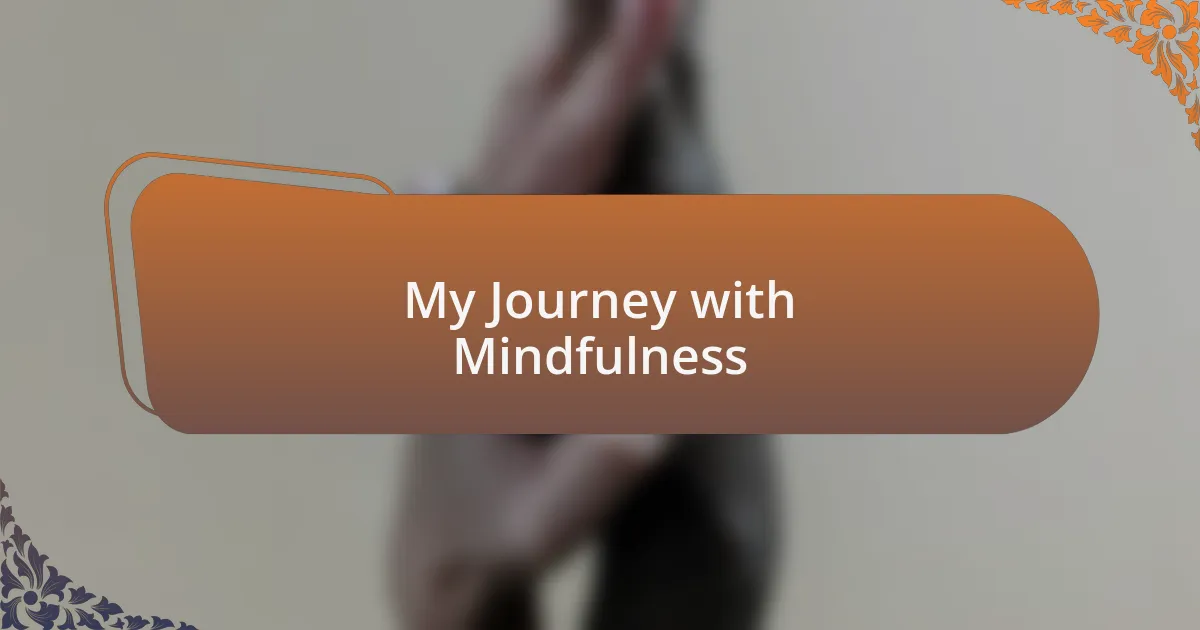
My Journey with Mindfulness
My journey with mindfulness began in a simple yet profound way. I remember sitting quietly in my room, attempting to meditate for the first time. Initially, my mind raced with thoughts, but with each session, I began to notice a strange sense of comfort. It was as if I was peeling back layers of anxiety, discovering a calmer version of myself underneath.
One afternoon, after a difficult social situation, I found myself overwhelmed by emotions. Instead of letting those feelings consume me, I paused and practiced mindfulness by observing my surroundings—how the sunlight danced through the trees and the soothing sound of birds nearby. This practice taught me the importance of being present; it allowed me to find beauty in moments of chaos, a skill that has served me well in challenging situations.
Reflecting on those experiences, I often ask myself: how does this practice help me today? It has become a tool for navigating life’s unpredictabilities. By embracing mindfulness, I’ve learned to approach situations with curiosity rather than fear, gradually transforming my relationship with silence.
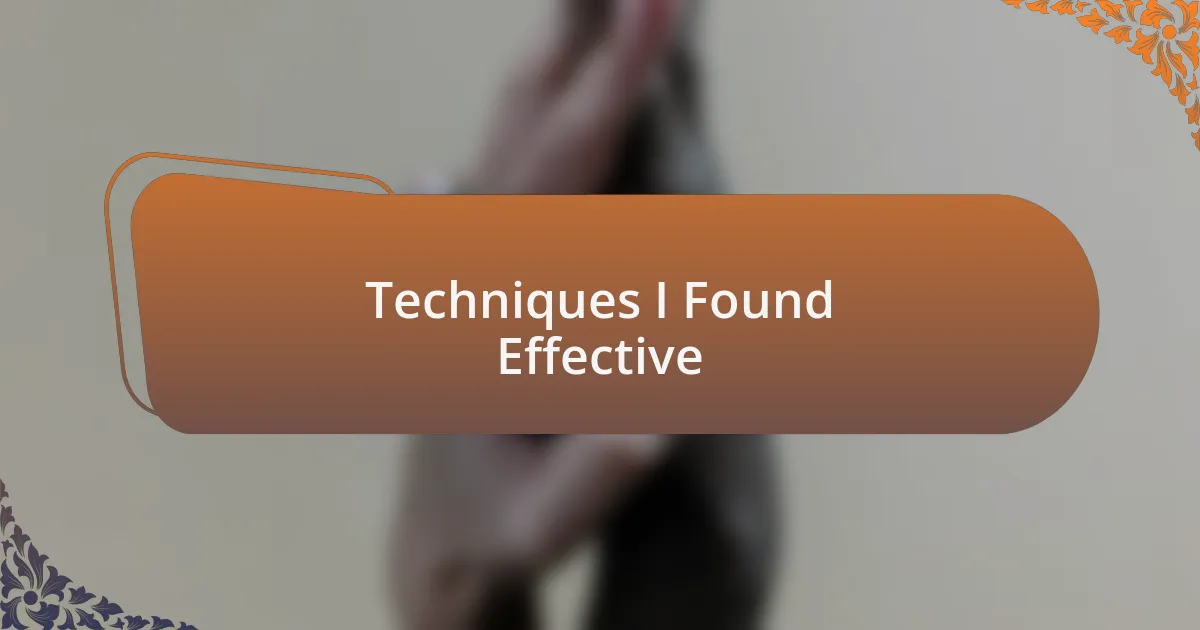
Techniques I Found Effective
Embarking on my mindfulness journey led me to discover the power of deep breathing techniques. I vividly recall a moment before a speech where anxiety threatened to take over. By focusing on my breath, inhaling deeply through my nose and exhaling slowly, I felt my heart rate slow down, creating a sense of calm that helped me regain my focus. It’s fascinating how something as simple as breath can anchor you in the present.
Another technique that has truly resonated with me is body scanning. I experienced it during a mindfulness workshop, and it revealed unexpected areas of tension. As I consciously directed my attention to different parts of my body, I noticed how much I’d been holding stress in my shoulders. This realization shifted my perspective—why do we carry these burdens unnecessarily? I now use body scans regularly to check in with myself and release any discomfort, making it a crucial part of my daily routine.
Journaling has also emerged as a powerful mindfulness tool for me. Each night, I take a few moments to jot down my thoughts and feelings, transforming my inner dialogue into something tangible on the page. Through this practice, I’ve gained insights into my emotions, often uncovering layers of anxiety I hadn’t recognized before. It’s not just about writing; it’s about forging a deeper connection with myself. Have you ever tried to put your feelings into words? The clarity that follows is often enlightening.
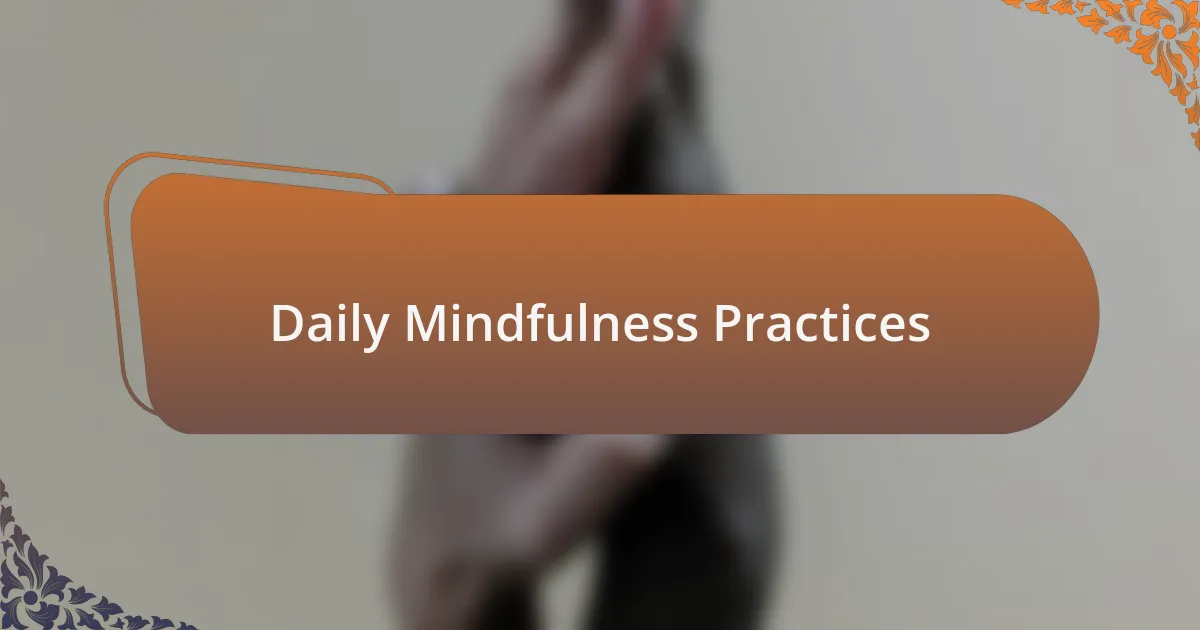
Daily Mindfulness Practices
One daily practice I’ve found invaluable is mindful walking. As I step outside, I focus on each foot connecting with the ground, feeling the textures beneath my shoes. It’s amazing how this simple act can pull me into the present moment. Have you ever taken a walk where you actually noticed the beauty around you? Engaging with the sights and sounds activates my awareness, allowing me to temporarily set aside any worries or distractions.
Another practice I incorporate involves leveraging everyday activities, like washing dishes. Instead of letting my mind wander, I immerse myself in the sensations of the water, the warmth on my skin, and the rhythmic motion. This approach always leaves me feeling centered and recharged. Doesn’t it feel refreshing to extract mindfulness from mundane chores? By inviting awareness into these moments, I cultivate gratitude for the simple joys in life.
One technique that has transformed my mornings is practicing gratitude. Each day, I take a few minutes to reflect on three things I’m thankful for. This ritual shifts my mindset from what I lack to appreciating what I have. I often find myself smiling as I recall moments that brought me joy, even if they were small. How often do we pause to recognize the positive aspects of our lives? Acknowledging these blessings has definitely helped me foster a more mindful and positive outlook throughout my day.
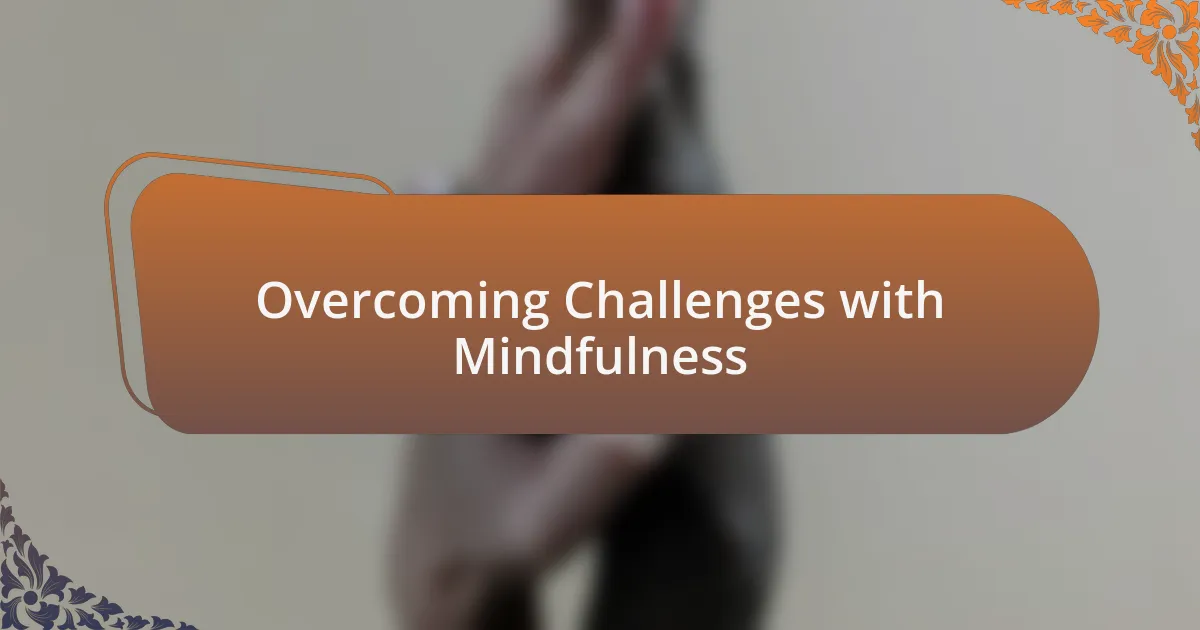
Overcoming Challenges with Mindfulness
Cultivating mindfulness has truly helped me navigate some of the more daunting aspects of daily life, especially when faced with challenges related to selective mutism. I remember a particularly stressful situation when I was invited to speak at a small gathering. Rather than succumbing to my anxiety, I took a moment to breathe deeply and center my thoughts, focusing on the sensations in my body. This practice allowed me to transform that anxiety into a sense of calm, making it easier to express myself.
One challenge I’ve encountered is dealing with unexpected situations that trigger my reluctance to communicate. I discovered that taking a brief pause to practice mindful breathing—a technique that has become second nature to me—can create a crucial moment of clarity. When facing overwhelming circumstances, I ask myself, “What am I feeling right now?” This question grounds me and often leads to insights I might have overlooked, like realizing that the pressure to speak can sometimes be eased.
I often find myself connecting with others through non-verbal cues when words feel like an avalanche. Engaging silently can feel just as powerful as verbal communication, reminding me that connection isn’t solely reliant on speech. Have you ever experienced a moment where a shared glance spoke volumes? These mindful techniques encourage me to appreciate the rich tapestry of human interaction, even when words aren’t part of the equation.
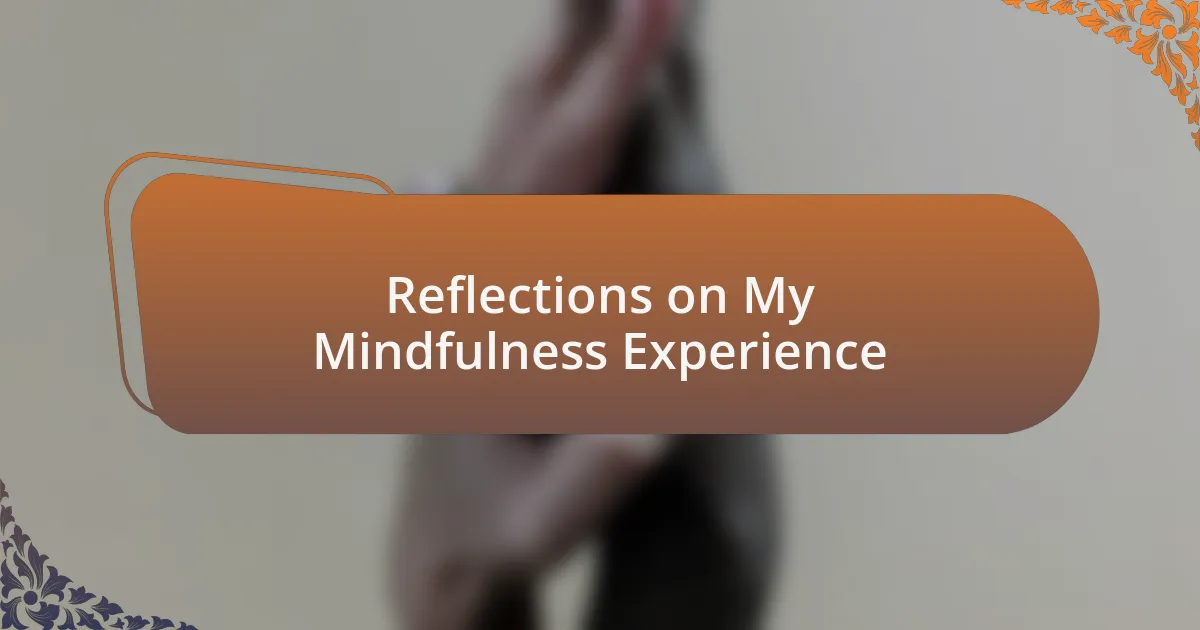
Reflections on My Mindfulness Experience
Practicing mindfulness has truly altered my perception of communication challenges. I vividly recall a time when I was surrounded by friends at a café, and I felt the familiar urge to retreat into silence. Instead of withdrawing, I focused on the warmth of my coffee cup, letting the comforting sensation anchor me. I noticed that in tuning into that moment, I was able to join the laughter around me, even if just by listening attentively. How powerful is it to engage without uttering a word?
One evening, as I sat alone in my room, I experimented with a technique called mindful observation. I chose to focus on a single sound—a ticking clock. By immersing myself in that rhythm, I suddenly became aware of my racing thoughts and fears about speaking up. This realization led me to understand that some of my anxiety stemmed from self-imposed pressure to be perfect. Have you ever paused long enough to realize how much your own thoughts can influence your feelings? It was a breakthrough moment for me, shifting my perspective from avoidance to acceptance.
Reflecting on my journey, I’ve found that mindfulness not only helps in grounding myself but also deepens my emotional intelligence. There was a moment at work when a colleague shared a personal story, and I felt an urge to respond with my own experience—something I would have previously struggled with. Instead of panicking, I practiced mindful listening, allowing the silence to be part of the conversation. This experience left me with a profound appreciation for space—space to think, to feel, and to ultimately connect, even if it wasn’t through spoken words. How often do we overlook the power of listening?